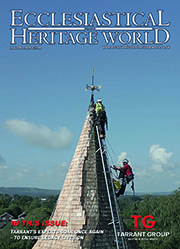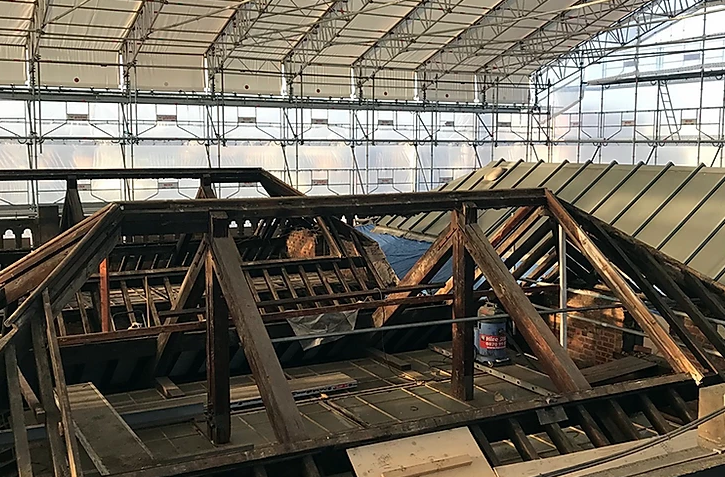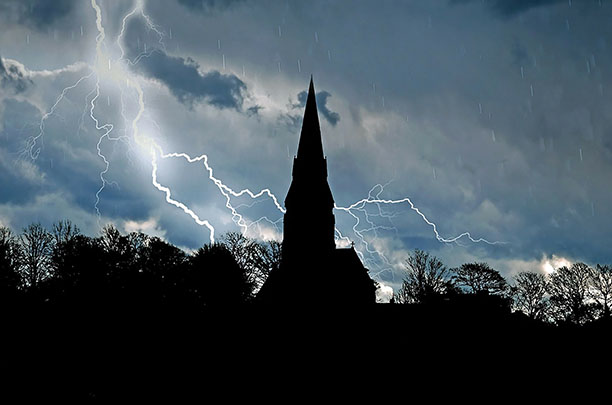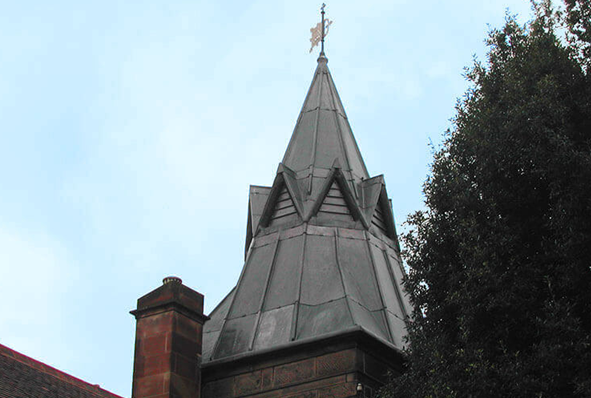Heritage Roofing
Heritage roofing - maintaining our iconic buildings
The UK is home to some of the most iconic buildings in the world, from stunning churches and cathedrals to historic stately homes. Each and every one of these remarkable feats of architecture requires regular maintenance to ensure they remain in the very best condition, allowing them to be enjoyed for generations.
Lightning Protection
When lightning strikes are you protected against this act of God?
The issue of lightning protection in churches is one that has exercised this publication for many years. In this four-part series of spotlights on the issue we will be revisiting various aspects of the subject, beginning with an overview of current thinking.
Traditional Lime
Lime: it’s better for buildings – and for the environment
It is now fairly well known that cement is not good for old buildings and that lime mortar should be used. But why? What are the advantages and what are the disadvantages? In order to begin to answer those questions it is necessary to understand the nature of traditional building, the process by which buildings used to be built, and how it differs from modern construction, the process by which we build today.
Audio Visual
Audio visual equipment in church buildings
This guidance is issued by the Church Buildings Council under section 55(1)(d) of the Dioceses, Mission and Pastoral Measure 2007. As it is statutory guidance, it must be considered with great care. The standards of good practice set out in the guidance should not be departed from unless the departure is justified by reasons that are spelled out clearly, logically and convincingly.
Read More...
CRE Events
Churches are coming under starter’s orders for CRE 25
Churches across the nation are beginning to make preparations for their visit to Christian Resources Exhibition’s CRE 25.
Insurance
You need to ensure that reasonable precautions are in place at your church to keep it safe for those who use it. To do this, you need to think about what might cause harm to people.
You will then need to decide if the precautions already in place are adequate. If they are not, you may need to identify further action to prevent any danger. When done formally, this is known as a risk assessment.
LPOW Grants
£23 million government package to support restoration of thousands of listed places of worship
Heritage Minister Sir Chris Bryant has announced that the Listed Places of Worship Grant Scheme will be extended into the next financial year, providing £23 million so that thousands of historical buildings, including churches, synagogues, mosques and temples, can carry out restoration work.
Lead Roofing
Lead is one of the oldest materials in the roofing industry and is still commonly used throughout the world today.
Lead roofing is a traditional roofing method which has been used in the industry for hundreds of years, and is therefore proven to be extremely reliable. Lead roofing, and sand-cast lead, in particular is ideal for old buildings such as churches or historical renovations, whereas milled lead roofing is a mass-produced alternative, used for precision and accuracy in homes and commercial buildings alike.
Home
History Shaping History: The Importance of Research
James Weir Historic Buildings Consultant
In September 2009, the RICS published its first edition Guidance Note on Historic Building Conservation; intended primarily as a reference guide to building surveyors working on historic buildings and as an encouragement to their further development, the guide has set the basic understanding for any surveyor working in this area.
The importance of the guide lies not only in its publication to the whole gamut of RICS members, but also in one small sentence, which nonetheless encompasses a much wider, national drive:
The first need for practitioners is a sound background knowledge of architectural and building history (and, as importantly, local history) to enable them to ‘read’ and understand the building and its context.
Of course, this is not a new message. As far back as 1998, the British Standards Institution, working with nearly 30 other professional bodies, amenity societies and other groups, published BS.7913 – The Principles of the Conservation of Historic Buildings. Now this may seem like a lofty ambition, for the Institution that publishes standards as varied as Testing Fresh Concrete or Specification for Domestic Gas Meter Boxes and Meter Bracket to attempt to codify something that has spawned myriad philosophies, controversies, volte-faces, books, theses and the rest for centuries. Once again, however, there is a telling emphasis:
In advance of any building operations, sufficient survey, investigation, evaluation and recording should be undertaken to give reasonable confidence that the building, its development and historical importance are sufficiently understood, that nothing of significant value is likely to be inadvertently damaged or destroyed, and work appropriately designed and specified.
This message is clearly fundamental to anyone, surveyor or otherwise, working in, on, with, under or over historic buildings. Indeed, how can anomalies, such as the seemingly
superfluous ledge to the gable end of this late 17th century house (Fig. 1), be understood without investigation? With buildings with a complicated history, this kind of understanding is even more vital; even if concrete conclusions cannot be reached, the extent of what the evidence allows should at least be set out.
Yet, during the last year, this need has now been reinforced more than ever before with the Government’s publication of Planning Policy Statement 5 – Planning and the Historic Environment in March 2010; this English Heritage-endorsed document replaced PPG15, which had been a bedrock reference for Local Authorities, surveyors and a host of heritage practitioners for 16 years. PPS5 is more specific in its requirement that the ‘applicant [is] to provide a description of the significance of the heritage assets affected and the contribution of their setting to that significance’. In this sentence, the thrust of BS.7913 above is made unavoidable; those wishing to alter, extend, restore or even demolish historic buildings in any way must engage with the history of that building.
Now documents are one thing, but what does this mean in practise? Clearly many applicants will not have the time or skills to undertake this adjunct to their proposals and so many are turning to heritage professionals for preparation of Heritage Impact Assessments, which most, if not all, Local Authorities are now insisting upon for any listed building consent applications. Though this places additional burdens on the applicant, the benefit is overriding: proper expertise, time and effort can now be applied, proportionate to the proposals at hand, to judging the impact of proposals, whilst simultaneously encouraging owners of historic buildings to accept the responsibility of caring for that building and, perhaps, to seek more knowledge as a result. As a bonus, we can hope that this will gradually deter those more unscrupulous coveters of our built-heritage, who acquire merely to destroy. Furthermore, it is a welcome opportunity for historic buildings professionals to act in the interests of the building in a more outspoken way, as their opinions are now being sought as a matter of course. We might also succeed in making our voices heard to counter the kind of detrimental planning decisions that characterised much of the last century.
The spirit of PPS5, along with the other documents quoted, applies equally, if not more so, to ecclesiastical heritage, itself exempted from traditional the same listed building controls. Churches are a vital connection with a past that few other buildings can match, as well as a fundamental connection with the English landscape. How can professionals working on churches possibly understand their need if they do not understand the building? Given their age, churches have been the subject of countless repairs, bodges, additions, re-buildings and of course the seemingly-inescapable eye of the Victorian restorers – all of which conspires to mislead, confound and deceive the unwary. The works of the latter are sometimes especially slippery to pin down on site and sometimes only research will answer.
The need for history is clearly now inextricably linked with managing change in listed buildings more than ever before but, as a final thought, could we not extend this spirit beyond the official limits of the documents? For example, should we building surveyors and historic buildings consultants reading the RICS guidance note not employ this wider philosophy even in surveys and quinquennials? Yes, client funds are tight and profit margins tighter, but that little extra effort to consult local history sources or archives can illuminate the rather dry survey report into a more realistic reflection of how history, as much as physical forces, have shaped the building or church and how history, as much as functionality, should inform its future repairs and development.

Figure 1. What is this ledge to the gable-end of this late 17th century house in Oxfordshire? (Author)

Figure 2. Smallhythe Place, Kent – exactly what was its original purpose? (Author)

Figure 3. How far did Victorian restoration go in this Dorset church? (Author)




















